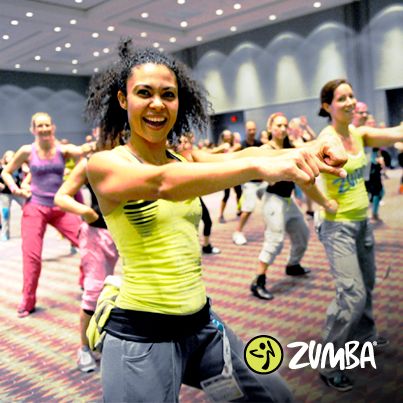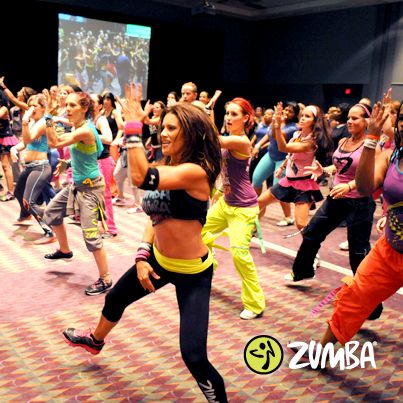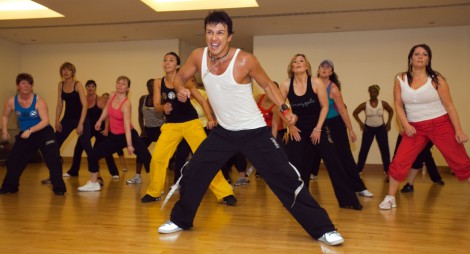One of my favourite exercise types is Zumba. In today’s article I am going to give you a bit of insight into this fitness programme. If you can dance a bit or are used to other types of dynamic aerobic classes, it won’t be difficult for you. If you have never danced or participated in choreographed aerobic classes perhaps it will take a couple of occasions to be able to follow the routine. Don’t be shy or afraid of trying. Just give it a go and get hooked. It is fun!
Zumba = Fitness & Fun
Zumba is an exciting and dynamic fitness regime, which involves dance and aerobic elements. The programme includes steps from a range of dances including chachacha, cumbia, flamenco, soca, samba, salsa, merengue, mambo, reggaeton, rumba and tango. You may even find hip-hop, belly dance, Indian Bollywood and bhangra dance moves in a Zumba regime, as well as squats and lunges. It is sometimes fast-paced and sometimes slow and the various Zumba regimes vary. Instructors have the freedom to assemble their own routine, that’s why Zumba classes can be quite different. Nonetheless, all use the same steps and step combinations, so it is surprisingly easy to adapt to different classes run by different instructors, once you got the feel for it.
Zumba classes tend to be an hour long, just like normal aerobic classes. The fast and slow dance elements & the varying rhythms change, supporting cardio health. Most of the time they are accompanied by some resistance training, too. There are eight different Zumba class types, which suit different ages, fitness levels and fitness objectives. These include special classes like Zumba Gold, targeting the elderly; and Aqua Zumba for those who wish to exercise in the swimming pool. All of the regimes are done to high-energy music and their objective is to motivate you to exercise in a fun way. The key elements of Zumba is to have fun and stay fit.
The Humble Start of a Global Success Story
Zumba was invented by a Columbian dancer and fitness instructor, Alberto “Beto” Perez. Stories about the origins of Zumba suggest that he substituted an injured aerobic instructor in a local gym in his Columbian home town, back in the 1990s. However, he forgot to take the tape with him. Fortunately, he had a Latin music tape in his backpack, so he decided to use that and improvise. His accidental dance aerobic class became an instant hit and a new style, “Rumbacise” set off on its successful journey. It was so successful, the gym kept it on its schedule. Fast forward a few years, Beto moved to Miami. He renamed and refined “Rumbacise”, teamed up with other entrepreneurial spirits and launched “Zumba”. Within a few years, the fitness regime of Beto had reached an audience in 150 countries and had become a widely popular programme all around the globe. As the company’s CEO and Marketing & Business Development Expert, Alberto Perlman suggests that Zumba: “offers South Beach coolness with classic Latin American and Colombian flavour, mixing them into something unique and distinctive”. This must be the core of Zumba’s worldwide success.
Zumba Today
Zumba is not only a widely popular fitness regime that you can practice in lots of local gyms all around the world. It is much more than that. It is a fitness empire – running under the name “Zumba Fitness” – which does not charge licensing fee from gyms but offers unique training and membership services to instructors. Within eight hours of formal training, anyone can become a licensed instructor for approximately USD 250. Once licensed, for a monthly membership fee, instructors may become members of the Zumba Instructor Network (ZIN). The ZIN provides fresh and unique choreography, new music choices, marketing support and a listing of vacancies for licensed instructors.
Zumba also offers its own clothing and footwear line and accessories, CDs, DVDs and Zumba-themed video games. The company commissions Latino musicians to create music for Zumba classes and nurtures young Latino artists, dancers and choreographers, too.
Research Proves Benefits of Zumba
Researchers at the University of Wisconsin-La Crosse’s Department of Exercise and Sport Science were mandated by the American Council on Exercise to conduct scientific research on Zumba, to determine whether it is an effective form of physical exercise.
The researchers used volunteers regularly attending Zumba classes to determine exercise intensity and energy expenditure during class. Once the baseline fitness levels of volunteers had been determined, the volunteers regularly participated in Zumba classes equipped with heart-rate monitors. It transpired that an average of 369 calories are burnt during a Zumba class. Zumba therefore helps with weight loss or weight maintenance. The research suggests that it burns more calories than other types of exercise including cardio kickboxing, step aerobics and power yoga. The data suggested that Zumba boosts cardio endurance regardless of existing fitness level. Zumba proved to be a total-body exercise useful for core strengthening and improving flexibility, too.
Zumba is therefore not only fun but very effective in helping you achieve your fitness goals. If you have experience with Zumba, know about further benefits or just have an interesting story connected to a Zumba class, let us know!




